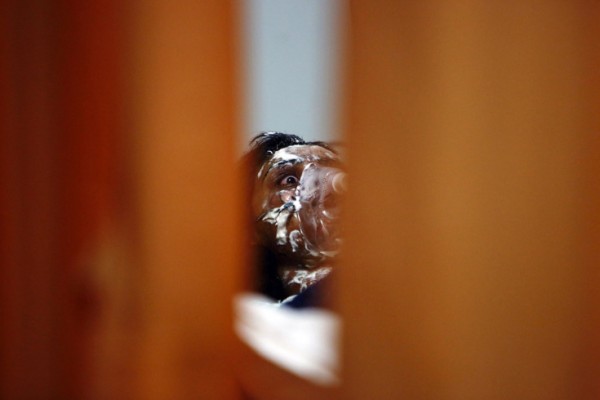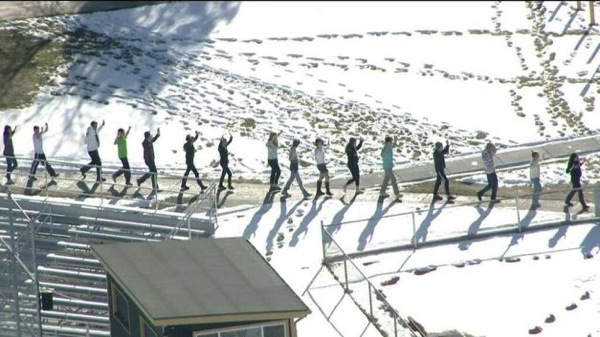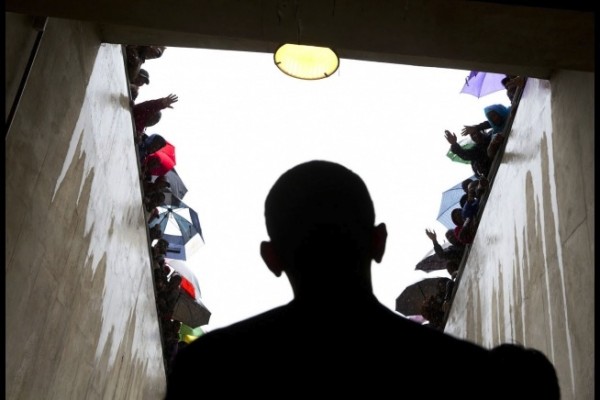Notes
She is Seeing Terror. You are Seeing Terror. We Will Continue to See Terror.
She has seen terror, she is seeing terror, you are seeing terror, we will continue to see terror. The grammar is at once familiar and out of place; we might call it a declension of violence.
The caption said, “A victim, with her eyes wide open, lies on a hospital bed after an attack on a passenger microbus by an unidentified group in Kathmandu.” Too many elements of this scenario are all too familiar: civilians being targeted by unknown attackers, institutional support coming after–not before–the carnage, while eyes are wide open yet seemingly unconnected to any means to stop the violence.
And not just her eyes: ours are open (and perhaps opened) as well. We see her and we see her seeing, which raises the stakes for photography’s promise as a communicative art. It seems that the photograph might channel her seeing directly into ours, or, if that connection fails, at least consider what she might be seeing and what we ought to see.
In this case, whatever still holds her eyes in fixed, horrified attention remains invisible to us. All we can see is the terror itself: How it stuns body and soul; how it drives consciousness to a fixed point of horror amidst a welter of disorder, confusion, and pain. How she is too transfixed by the damage to even be able to plead for help, much less for an end to the arbitrary slaughter of human beings.
The photograph’s intelligence doesn’t end there, however, for it starkly highlights how much we don’t know simply by seeing. Our vision is limited to a portion of her face, and we see that through a slit in the curtain along her bed. The narrow aperture is as salient as the face behind it, while the blinds on each side make a thick frame designed to obscure. The message is clear: what you see through the aperture of the camera is not the whole picture.
Too often the full import of that point is misunderstood, not least by those who suggest that adequate compensation is available otherwise. Better captions, extensive written reportage, historical study, ethnographic immersion–whatever the alternative, the idea is that an adequate corrective is available. Those and other investments are certainly needed, and not just in the war zones, but I think this photograph goes one better.
It says that the whole picture is never available. Pull aside the curtains, and what do you see but the rest of the battered body? Interview the doctors and emergency workers and bystanders and diplomats, and what do you know? One can learn quite a bit, but nothing that will erase her terror. That may be why the oxygen mask is so, well, terrifying: she seems to have been transformed into something half-bestial, a declension from human to merely animal, from person to prey, and at the mercy of those in the room now instead of those who threw the bomb. Somehow even the medical technologies, like the technology of the camera, have been co-opted into an apparatus of terror, as if they and not the bomb were harming her. That’s not true, but it is one measure of how terror works by making the familiar world into an environment of pain and fear.
Of course, everything that can be done to help the victim and to understand the situation should be done, but one does need to beware the illusion that all distance between the victim and the unharmed can be eliminated. This photo, by contrast, shows us how that distance is part of our experience of her experience. We are able to see that something awful lies beyond mediation, and thus beyond knowledge, and that our experience is mediated. Yet, for all that, we are still put in a relationship with a single bombing victim far away from most of those who will see this photograph. That’s why the photo has more than academic interest. You might say that one of the contributions of photography is that it shows how solidarity with others doesn’t have to wait on fully sharing or understanding their experience.
The photo shows us terror that is stalking the world today, and it reminds us that many viewers are fortunate enough to see it at at distance. The close framing of her act of wide-eyed concentration reminds us that she may not be seeing what is in fact in front of her–she could be blind to the room because still back in the blast–and that we may not be seeing what is in fact in front of us.
Perhaps it suggests that context is needed, but I think that is settling for too little. She isn’t looking at us, but the photograph does ask at least one question on her behalf: Now that you see how she has been changed by the attack, how have you been changed? Who is willing to look terror in the face, and to stand with those who continue to suffer?
–Robert Hariman
(cross-posted from No Caption Needed)
(photo: Navesh Chitrakar/Reuters)



Reactions
Comments Powered by Disqus